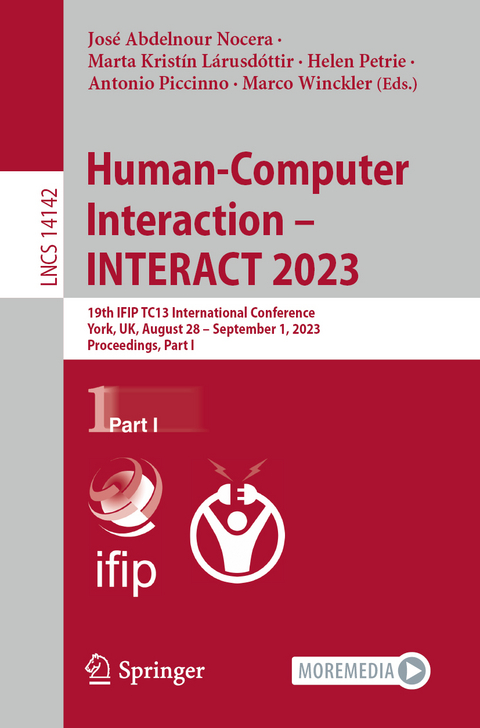
Human-Computer Interaction – INTERACT 2023
Springer International Publishing (Verlag)
978-3-031-42279-9 (ISBN)
The 71 full papers and 58 short papers included in this book were carefully reviewed and selected from 406 submissions. They were organized in topical sections as follows: 3D Interaction; Accessibility; Accessibility and Aging; Accessibility for Auditory/Hearing Disabilities; Co-Design; Cybersecurity and Trust; Data Physicalisation and Cross-device; Eye-Free, Gesture Interaction and Sign Language; Haptic interaction and Healthcare applications; Self-Monitoring; Human-Robot Interaction; Information Visualization; Information Visualization and 3D Interaction; Interacting with Children; Interaction with Conversational Agents; Methodologies for HCI; Model-Based UI Design and Testing; Montion Sickness, Stress and Risk perception in 3D Environments and Multisensory interaction; VR experiences; Natural Language Processing and AI Explainability; Online Collaboration and Cooperative work; Recommendation Systems and AI Explainability; Social AI; Social and Ubiquitous Computing; Social Media and Digital Learning; Understanding Users and Privacy Issues; User movement and 3D Environments; User Self-Report; User Studies; User Studies, Eye-Tracking, and Physiological Data; Virtual Reality; Virtual Reality and Training; Courses; Industrial Experiences; Interactive Demonstrations; Keynotes; Panels; Posters; and Workshops.
3D Interaction.- AHO-Guide: Automatically Guiding the Head Orientation of a Local User in Augmented Reality to Realign the Field of View With Remote Users.- Point- and Volume-based Multi-Object Acquisition in VR.- Using Mid-Air Haptics to Guide Mid-Air Interactions.- Accessibility.- Brilliance and Resilience: A New Perspective to the Challenges, Practices and Needs of University Students with Visual Impairments in India.- Mapping Virtual Reality Controls to Inform Design of Accessible User Experiences.- WAM-Studio: A Web-based Digital Audio Workstation To Empower Cochlear Implant Users.- Web Accessibility in Higher Education in Norway: To What Extent are University Websites Accessible?.- Wesee: Digital Cultural Heritage Interpretation for Blind and Low Vision People.- Accessibility and Aging.- Accessibility Inspections of Mobile Applications by Professionals with Different Expertise Levels: an Empirical Study Comparing with User Evaluations.- Evaluating the Acceptance of a Software Application Designed to Assist Communication for People with Parkinson's Disease.- "The Relief is Amazing": An In-situ Short Field Evaluation of a Personal Voice Assistive Technology for a User Living with Dementia.- Towards an Automatic Easy-to-Read Adaptation of Morphological Features in Spanish Texts.- Accessibility for Auditory/Hearing Disabilities.- Challenges faced by the Employed Indian DHH Community.- Haptic Auditory Feedback for Enhanced Image Description: A Study of User Preferences and Performance.- Using Colour and Brightness for Sound Zone Feedback.- Co-Design.- Common Objects for Programming Workshops in Non-Formal Learning Contexts.- Engaging a project consortium in ethics-aware design and research.- Exploring Emotions: Study of Five Design Workshops for Generating Ideas for Emotional Self-Report Interfaces.- Moving Away fromthe Blocks: Evaluating the Usability of EduBlocks for Supporting Children to Transition from Block-Based Programming.- Cybersecurity and Trust.- Dark Finance: Exploring Deceptive Design in Investment Apps.- Elements that Influence Transparency in Artificial Intelligent Systems - A survey.- Empowering Users: Leveraging Interface Cues to Enhance Password Security.- Friendly Folk Advice: Exploring Cybersecurity Information Sharing in Nigeria.- Trust in Facial Recognition Systems: A Perspective From the Users.- Data Physicalisation and Cross-device.- Comparing Screen-based Version Control to Augmented Artifact Version Control for Physical Objects.- EmoClock: Communicating Real-Time Emotional States through Data Physicalizations.- Extending User Interaction with Mixed Reality through a Smartphone-based Controller.- Fitts' Throughput vs Empirical Throughput: A comparative study.- Eye-Free, Gesture Interaction and Sign Language.- Developing and Evaluating a Novel Gamified Virtual Learning Environment for ASL.- Effects of Moving Speed and Phone Location on Eyes-Free Gesture Input with Mobile Devices.- Hap2Gest: An Eyes-free Interaction Concept with Smartphones Using Gestures and Haptic Feedback.- User-Centered Evaluation of Different Configurations of a Touchless Gestural Interface for Interactive Displays.- Haptic interaction.- Assignment of a Vibration to a Graphical Object Induced by Resonant Frequency.- GuidingBand: A Precise Tactile Hand Guidance System to Aid Visual Perception.- Mid-Air Haptic Cursor for Physical Objects.- Stress Embodied: Developing Multi-Sensory Experiences for VR Police Training.- Healthcare applications and Self-Monitoring.- Co-designing an eHealth Solution to Support Fibromyalgia Self-Management.- Designing Remote Patient Monitoring Technologies for Post-Operative Home Cancer Recovery: The Role of Reassurance.- SELFI: Evaluation of Techniques to Reduce Self-report Fatigue by Using Facial Expression of Emotion.- Usability and Clinical Evaluation of a Wearable TENS device for Pain Management in Patients with Osteoarthritis of the Knee.
| Erscheinungsdatum | 26.08.2023 |
|---|---|
| Reihe/Serie | Lecture Notes in Computer Science |
| Zusatzinfo | XXXI, 653 p. 174 illus., 157 illus. in color. |
| Verlagsort | Cham |
| Sprache | englisch |
| Maße | 155 x 235 mm |
| Gewicht | 1027 g |
| Themenwelt | Mathematik / Informatik ► Informatik ► Betriebssysteme / Server |
| Informatik ► Software Entwicklung ► User Interfaces (HCI) | |
| Schlagworte | Artificial Intelligence • Communication Systems • Computer Hardware • Computer Networks • Human-Computer Interaction (HCI) |
| ISBN-10 | 3-031-42279-1 / 3031422791 |
| ISBN-13 | 978-3-031-42279-9 / 9783031422799 |
| Zustand | Neuware |
| Haben Sie eine Frage zum Produkt? |
aus dem Bereich


